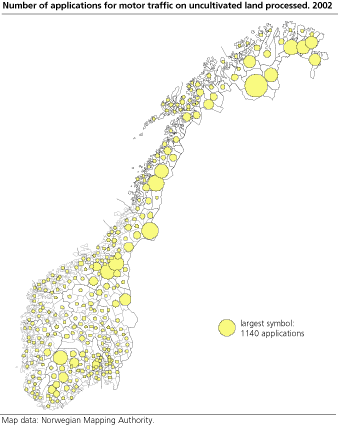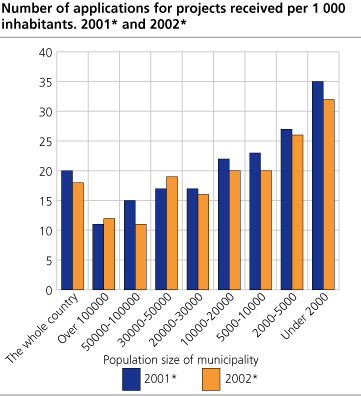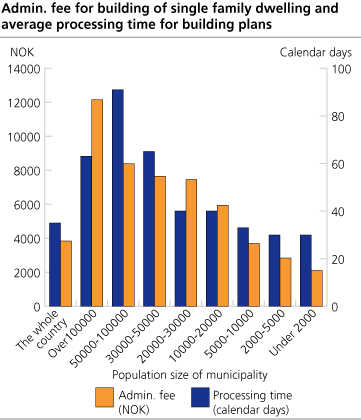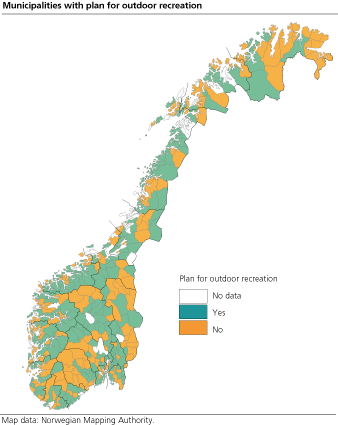Content
Published:
This is an archived release.
Exemptions for motor traffic in uncultivated areas usually granted
Norwegian municipalities granted 93 per cent of all applications for motor traffic in uncultivated areas in 2002. This is about the same figures as in 2001. The number of applications is unevenly distributed among the municipalities, but this has little effect on the share of exemptions granted.
Motor traffic in uncultivated areas is in principle prohibited. However, under the Act relating to motor traffic on uncultivated land and in watercourses, local government authorities may grant exemptions from the Act, allowing the use of motor traffic for certain purposes. No data on actual traffic is available, but KOSTRA provides information on the use of exemptions by local government authorities.
Municipal land conservation
The conservation of areas for environmental purposes are generally implemented through acts managed by central authorities. But through the plan and building act the municipalities have the possibility to give areas of special value legal protection against development.
All together, there are 1747 protected areas for the purpose of cultural heritage, in average 5 in each municipality that reported in KOSTRA 2002. 384 areas are protected for the purpose of nature conservation. In 2002, 208 and 60 new areas were protected for the purpose of cultural heritage and nature conservation respectively. The reporting in KOSTRA also shows that municipalities that have special plans for outdoor recreation and cultural heritage also have higher expenses per inhabitant to support these interests.
Tables:
- Table 1 Processing of applications for exemptions under the Act relating to motor traffic on uncultivated land and in water courses
- Table 2 Municipal preservation of cultural heritage and protection of nature
- Table 3 Municipal initiatives relating to cultural heritage
- Table 4 Indicators of municipal prioritizing of outdoor recreation
Exemptions in green areas normally approvedOpen and readClose
Building projects in "green areas" require exemptions by the municipalities to be approved. Of all applications in 2002, 70 per cent were approved. This is the same figure as in 2001. The county councils, who manage the law of cultural heritage, approved 84 of all applications for exemptions in 2002, a significant increase from the year before when 78 per cent were approved.
These results are taken from the reporting in KOSTRA 2002. The statistics does however not tell us how large or controversial the projects are, or if measurements are taken to reduce the impacts. Some municipalities will also give signals of likely rejections of applications in preliminary negotiations, and these are not included in the statistics.
Administration of plans in areas of particular environmental value
Plans can be binding or in the form of guidelines indicating which projects can be implemented. Reports on projects in areas of particular environmental value (defined as agricultural areas, areas of natural environment and outdoor recreation areas, the 100-metre belt along the coast and special areas set aside for the preservation of the cultural heritage) show that most applications are in accordance with plans and are approved.
Applications for exemptions from adopted plans are granted more often than they are rejected. This applies to all types of area. (It should be taken into account that we do not have any information as to the type of project to which an application applies, or as to the guidelines specified in the plans for the various projects).
The status of biological diversity, recreation and cultural heritage in municipal land-use planning
A municipality uses the land-use part of the municipal master plan as the basis for safeguarding areas of special value. This can be done in various ways, for example by adopting plans with a special focus on environmental assets such as biological diversity, opportunities for outdoor recreation and cultural heritage. Of these environmental assets, the municipalities place greatest emphasis on outdoor recreation Biological diversity does not seem to be high on the list of priorities. The same can be said of the cultural heritage.
The decisive factor underlying these differences may be municipalities perception of their areas of responsibility. Classic nature conservation and cultural heritage conservation has traditionally been regarded as a central government responsibility, while outdoor recreation has to a greater extent been delegated to local government
Land use management and municipal finances
In 2002, the municipalities used fees and other revenues to cover about half of their planning expenses. Net expenses for this purpose accounted for 0.74 per cent of total net municipal operating expenses. The size of fees increases with the size of the municipality, measured by population. This may be because more interests are affected by cases involving regulation or building in larger municipalities. There may be more objections, resulting in an increase in administrative load. It is also likely that the initial processing of these cases must be conducted more thoroughly because there are more considerations to be taken into account, and in order to avoid or be better prepared for subsequent objections or other complaints. The low fees in relation to the level of expenses in small municipalities may be partly related to the use of low fees as an incentive to attract new businesses.
Tables
- Table 1 Building project applications in areas of particular environmental value
- Table 2 Applications for exemptions relating to the cultural heritage act
- Table 3 Average processing time for regulation plans, building plans and subdivision of land including survey. By inhabitants in the municipality. 2002. Calendar days
- Table 4 Fees, operating income and operating costs in land-use planning. Average figures for groups of municipalities. NOK
- Table 5 Number of cases processed, by population numbers. Average, weighted by population. 2001 and 2002
- Table 6 The status of biological diversity, outdoor recreation and preservation of cultural heritage in municipal land-use planning. 2001 and 2002
- Table 7 Number of county authorities with plans for the different themes
- Table 8 Function 300 Land use planning. Main economic figures, by county
- Table 9 Functions 335, 360 and 365. Main economic figures, by county. 2002
- Table 10 Environmental functions in the county administration, functions 715, 716 and 750. Main economic figures. 2002. 1 000 NOK
Find more figures
Find detailed figures from Environmental management in local and county authorities
Additional information
Contact
-
Ingeborg Hauge
E-mail: ingeborg.hauge@ssb.no
tel.: (+47) 95 87 66 56
-
Jørn Kristian Undelstvedt
E-mail: jorn.kristian.undelstvedt@ssb.no
tel.: (+47) 94 50 68 64




